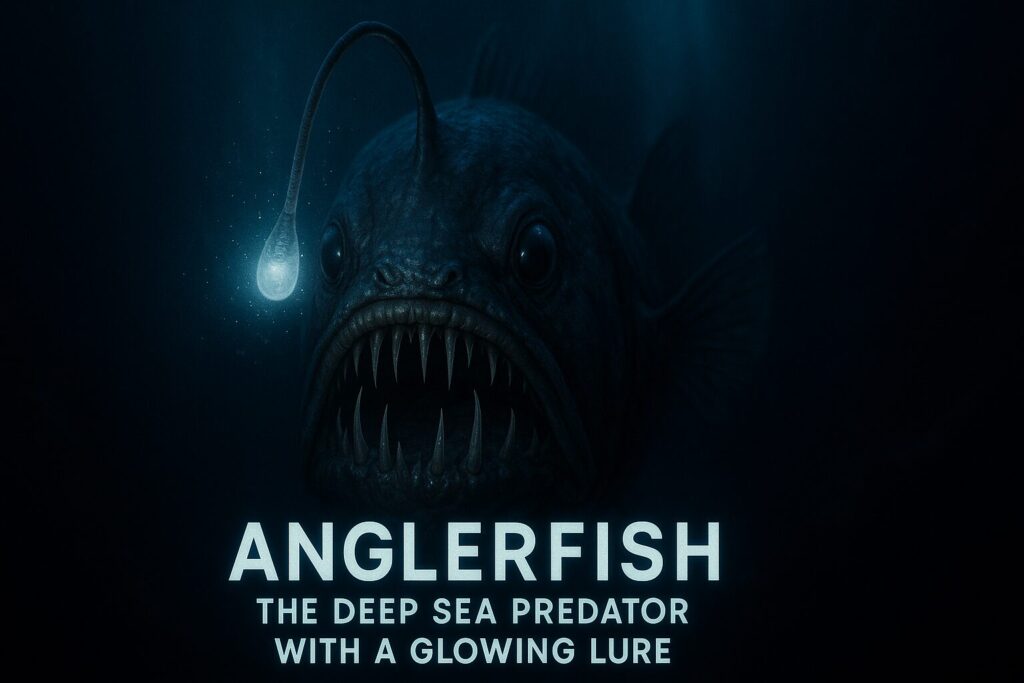Anglerfish: The Deep Sea Predator with a Glowing Lure – Discover the haunting world of anglerfish, from their glowing hunting lure to bizarre mating habits and surprising role in pop culture. Dive into the deep sea’s most mysterious predator.
Table of Contents
Introduction
In the darkest, most remote corners of the ocean lies a creature so strange, so otherworldly, that it seems born from science fiction. The Anglerfish is one of the deep sea’s most iconic predators renowned not only for its eerie appearance but also for its glowing lure and bizarre lifestyle. Dwelling thousands of meters below the surface, this enigmatic fish has evolved in total darkness, adapting to a world with crushing pressure, near-freezing temperatures, and scarce food.
What makes the Anglerfish so fascinating isn’t just its terrifying teeth or ghostly bioluminescent bulb. It’s the perfect symbol of how life can flourish in even the most inhospitable environments on Earth. From its alien-like anatomy to its mind-boggling mating habits, this predator challenges nearly every assumption we have about marine life.
In this article, we’ll explore the Anglerfish in depth from the science behind its glowing lure to the extremes of anglerfish reproduction, the incredible anglerfish living depth, and how various anglerfish species are reshaping our understanding of deep sea ecosystems. Let’s dive in.
What is an Anglerfish?
The Anglerfish is a carnivorous deep-sea fish belonging to the order Lophiiformes, comprising over 200 distinct species. While their sizes, shapes, and behaviors vary across species, what unites them is their predatory strategy: luring prey with a glowing, fleshy appendage that juts from their heads.
Most Anglerfish are small averaging about 8 to 20 cm (3 to 8 inches) in length. However, some species like the Gigantactis can reach sizes of over 40 cm. Despite their size, their grotesque features give them a fearsome reputation:
- Huge, fang-like teeth that angle inward, preventing escape once prey is caught.
- Expandable stomachs that allow them to swallow prey up to twice their own size.
- Jet-black or translucent skin to blend seamlessly into the pitch-dark ocean depths.
Interestingly, when people think of Anglerfish, they’re usually picturing the females, which are larger, equipped with the glowing lure, and responsible for hunting. Males, by contrast, are significantly smaller often just a fraction of the female’s size and have a completely different role in the species’ survival (more on that later).
There are both deep-sea and shallow-water Anglerfish, but the most famous and bizarrely adapted ones live in the bathypelagic zone a region of the ocean so dark and pressurized that very few organisms can survive.
This unique creature first came to popular awareness after it appeared in Finding Nemo, but the real-life Anglerfish is far stranger and more fascinating than any animated version.
Deep Sea Habitat: Where Anglerfish Live and Thrive
The Anglerfish thrives in one of the most extreme and least explored environments on Earth: the deep sea. Specifically, many species inhabit the bathypelagic zone, also known as the “midnight zone,” which stretches from 1,000 to 4,000 meters (3,300 to 13,100 feet) below the ocean’s surface. At these depths, sunlight doesn’t penetrate, temperatures hover just above freezing, and pressures can exceed 5,800 pounds per square inch over 380 times what we experience at sea level.
Anglerfish Living Depth and Zones
Depending on the species, Anglerfish can be found at different depths:
- Shallow-water Anglerfish, such as the frogfish, live near coral reefs or sea floors in shallower oceans.
- Deep-sea Anglerfish, like Melanocetus johnsonii (the “black sea devil”), reside in the bathypelagic or abyssopelagic zones, sometimes over 2,000 meters deep.
- Some species are even pelagic, meaning they drift freely in the water column rather than living near the sea floor.
This remote, high-pressure environment is characterized by:
- Near-total darkness, making eyesight nearly useless.
- Scarce food availability, requiring Anglerfish to be opportunistic feeders.
- Cold temperatures, often around 2 to 4°C (35 to 39°F).
- Minimal human disturbance, which is one reason they remain mysterious.
Adapted to the Abyss
To survive these hostile conditions, the Anglerfish has evolved some remarkable traits:
- Bioluminescent lures help attract prey and potential mates.
- Low metabolic rates allow them to conserve energy between rare feeding opportunities.
- Flexible jaws and expandable stomachs make it possible to devour prey larger than themselves.
Because of their deep habitat, studying live Anglerfish is notoriously difficult. Most scientific observations come from deep-sea trawling, remotely operated vehicles (ROVs), and rare in situ recordings, such as a 2014 deep-sea footage capture by the Monterey Bay Aquarium Research Institute (MBARI) the first ever of a live Melanocetus in its natural habitat.
The deep-sea world where Anglerfish live remains one of Earth’s final frontiers a vast, alien realm that we’ve barely begun to understand.
The Glowing Lure: How Anglerfish Use Bioluminescence to Hunt
Perhaps the most iconic feature of the Anglerfish is its eerie, glowing appendage that dangles from its head like a fishing rod. This specialized structure, called the illicium, ends in a fleshy bulb known as the esca, which emits a cold, ghostly light in the inky blackness of the deep sea. The phenomenon behind this glow is known as bioluminescence a biological light produced by living organisms.
How Does the Glow Work?
Unlike most forms of light we see on land, the Anglerfish doesn’t generate this glow by itself. Instead, it relies on a symbiotic relationship with bioluminescent bacteria. These bacteria live within the esca and produce light through a chemical reaction involving luciferin (a light-emitting molecule) and luciferase (an enzyme).
What’s particularly fascinating is that:
- The Anglerfish is born without these glowing bacteria.
- The bacteria are acquired from the surrounding seawater and colonize the esca early in life.
- The fish has specialized tissue that allows these microbes to thrive in a mutually beneficial relationship bacteria get a safe home and nutrients, while the fish gets a deadly light source.
A Deadly Trap in the Dark
The Anglerfish’s glowing lure is not just a visual oddity it’s a finely tuned predatory weapon. In the pitch-black ocean depths, light is rare and often signals food. The Anglerfish waves its glowing lure like a tiny fishing line, mimicking the movement of small prey such as plankton or shrimp. When curious creatures approach the lure, they’re ambushed with lightning-fast precision.
This ambush tactic offers several advantages:
- Conserves energy by avoiding the need for pursuit.
- Increases hunting efficiency in a low-food environment.
- Attracts prey from a distance that might not otherwise come near.
Some species even have adjustable lures that can flicker, pulse, or glow at different intensities, potentially mimicking different types of prey or using light patterns to lure specific targets.
In a place where vision is almost useless, the Anglerfish’s bioluminescence is not just a trick it’s a vital survival strategy, honed by millions of years of evolution in the world’s darkest waters
Unusual Anatomy: Adaptations That Make Anglerfish Unique
The Anglerfish looks like something out of a deep-sea horror film and for good reason. Its anatomy is a masterpiece of extreme adaptation, perfectly suited to the harsh conditions of the deep ocean. Every part of its body, from its monstrous mouth to its light-emitting lure, is tailored for survival where few other creatures can thrive.
Distinctive Physical Features
Here are some of the most striking anatomical traits of the Anglerfish:
- Illicium and Esca: The “fishing rod” (illicium) and the glowing bulb (esca) protrude from the head and are used to lure prey.
- Gigantic, hinged jaws: The Anglerfish’s jaws can unhinge and swing open wide enough to swallow prey as large as itself.
- Translucent or black skin: Deep-sea species often have ultra-dark pigmentation to blend into the blackness around them.
- Expandable stomach: Their stomachs can stretch to accommodate large meals, allowing them to feed efficiently in a food-scarce environment.
- Fang-like teeth: Long, translucent, inward-pointing teeth act like prison bars to trap prey once it enters the mouth.
Small Size but Big Impact
Most Anglerfish species are relatively small, often no longer than a teacup. However, their fearsome appearance and predatory tools give them a top-tier advantage. Some females reach up to 18–20 cm, while males are often only a few millimeters to 2 cm long.
This extreme sexual dimorphism where males and females differ dramatically in size and structure is one of the most extreme among all vertebrates.
Low Energy, High Efficiency
Living in a world with very little food has shaped the Anglerfish into an energy-conserving predator:
- Low muscle mass: Anglerfish don’t chase prey; they wait.
- Reduced skeletal density: Makes them neutrally buoyant and able to drift effortlessly.
- Reduced eyesight: Some species have poor vision, relying on the lure or chemical signals instead.
One of the most bizarre findings is that some Anglerfish have lost entire sections of their immune system, as reported in a 2020 Science study. This is thought to be related to their extreme reproductive strategy, where the male fuses to the female’s body (which we’ll explore next).
The Anglerfish isn’t just a strange creature it’s an evolutionary outlier, a symbol of life’s astonishing ability to adapt and flourish even in the harshest places on Earth.
Bizarre Mating Habits: The Shocking Truth About Anglerfish Reproduction
If the Anglerfish seems strange in appearance, its reproductive strategy is downright alien. The process of Anglerfish reproduction is one of the most extreme and bizarre in the animal kingdom and a perfect example of deep-sea adaptation taken to the biological limit.
Parasitic Mating: A Lifelong Bond
In many deep-sea Anglerfish species, males are born solely to find a female. They are tiny, underdeveloped, and lack most of the traits needed for survival, such as a functional digestive system. Their main goal? Locate a female quickly.
Here’s where it gets astonishing:
- Once a male finds a female, he bites onto her body.
- Over time, his tissues fuse with hers skin, blood vessels, even some organs.
- The male becomes a permanent, parasitic mate, living off the female’s bloodstream.
- In return, the female can access sperm on demand for the rest of her life.
A single female may carry multiple fused males a grotesque but efficient reproductive system in an environment where encounters are rare and unpredictable.
Why So Extreme?
This strategy evolved out of necessity. In the vast, pitch-black deep sea, the chances of two Anglerfish meeting are incredibly low. Traditional courtship, spawning, or social behavior would be evolutionarily impractical. So nature took a shortcut: fusion guarantees fertilization whenever the female is ready to spawn.
According to a 2020 study published in Science, researchers discovered that this fusion works because certain deep-sea Anglerfish lack key immune genes, which would otherwise cause the female’s body to reject the attached male. This is virtually unheard of in vertebrates and still puzzles scientists.
Other Reproductive Variations
Not all Anglerfish species reproduce this way. Some:
- Engage in temporary mating, where the male detaches afterward.
- Use external fertilization, where eggs and sperm are released into the water.
But the deep-sea “parasitic male” strategy is by far the most infamous and biologically fascinating.
In the world of Anglerfish reproduction, love literally means losing yourself body and all. It’s a shocking yet elegant solution to a harsh and isolating existence at the bottom of the sea.
Types of Anglerfish: Exploring the Different Species in the Deep
Though the term Anglerfish often evokes a single terrifying image a shadowy, sharp-toothed predator with a glowing lure this creature is far from a one-species wonder. In fact, there are over 200 known species of Anglerfish, spread across multiple families and found in oceans around the world.
These species vary widely in size, shape, behavior, and habitat, ranging from coral reef dwellers to abyssal nomads. Below are some of the most fascinating and scientifically notable types:
1. Melanocetus johnsonii (The Black Sea Devil)
- Perhaps the most famous Anglerfish, largely due to deep-sea footage captured by the Monterey Bay Aquarium Research Institute (MBARI).
- Females have a pronounced lure and hideously large teeth.
- Lives at depths of over 1,500 meters, in total darkness.
- Rarely observed alive in its natural habitat.
2. Lasiognathus (The Demon Anglerfish)
- Known for its grotesquely exaggerated lures, some shaped like multiple hooks or flags.
- The esca can pulse or wave to mimic live bait.
- Found between 1,200 and 4,000 meters below sea level.
- One of the few fish with a lure that has movable parts, almost like a puppet.
3. Cryptopsaras couesii
- A deep-sea species known for carrying multiple fused males on its body.
- The female is a relatively large predator, while the male is tiny and parasitic.
- Notable for being one of the earliest species through which the parasitic mating system was discovered.
4. Himantolophus groenlandicus (The Footballfish)
- Found in both the Atlantic and Pacific Oceans.
- Shaped like a grotesque underwater football with spikes and a lure.
- Lives at around 1,000 to 3,000 meters deep.
- One of the species occasionally caught by deep-sea trawling.
5. Antennariidae (Frogfish)
- These are shallow-water Anglerfish found near coral reefs.
- Use a similar lure but in clear, lit environments.
- Can “walk” across the sea floor with their pectoral fins.
- Masters of camouflage they mimic sponges, rocks, or coral.
6. Gigantactis (Giant Lure Anglerfish)
- Has one of the longest illicia (lures) relative to body size sometimes over 3 times its length.
- Females can reach up to 40 cm, while males remain tiny.
- Found at great abyssal depths often deeper than 2,500 meters.
Key Differences Among Species
| Trait | Shallow-water Frogfish | Deep-sea Black Sea Devil |
|---|---|---|
| Habitat | Coral reefs (100–200m) | Midnight zone (>1500m) |
| Lure Type | Non-glowing, mimicry-based | Bioluminescent |
| Size Difference (M/F) | Minimal | Extreme (Males are parasites) |
| Camouflage | Advanced | Irrelevant in darkness |
Each species of Anglerfish has adapted to its niche in astonishing ways. Whether it’s hiding among sponges in tropical reefs or floating like a phantom in the abyss, the Anglerfish shows nature’s incredible ability to diversify even under pressure (literally and figuratively).
Anglerfish in Pop Culture and Science: Myths, Memes, and Marine Biology
The Anglerfish has captured the human imagination like few other sea creatures. Equal parts terrifying and fascinating, it has inspired a blend of scientific awe, internet memes, and media portrayals that often blur the line between fact and fiction.
Pop Culture: The Face of Deep-Sea Horror
Most people’s first encounter with an Anglerfish comes through film or animation. Its grotesque, predatory appearance makes it a perfect stand-in for underwater monsters.
- Finding Nemo (2003): The Anglerfish appears in a memorable scene chasing Marlin and Dory, luring them with its glowing bulb. While exaggerated, the depiction helped popularize the fish’s real biological lure.
- Subnautica (video game): Features fictional deep-sea creatures heavily inspired by Anglerfish designs, playing on their horror potential.
- Aquarium Exhibits and Documentaries: Institutions like Monterey Bay Aquarium and BBC’s Blue Planet have showcased deep-sea Anglerfish with dramatic lighting and eerie soundtracks to highlight their mystery.
The Anglerfish’s visual design bulging eyes, gaping jaws, and that eerie glow has even made its way into Halloween decorations, comic books, and sci-fi alien designs.
Internet Memes and Misconceptions
On social media, Anglerfish are often used in “truth is stranger than fiction” memes. Common viral claims include:
- “This is a real animal” paired with shocking photos of deep-sea females.
- “Males fuse into the female forever” a fact so bizarre it’s often mistaken for satire.
- “Proof aliens already exist just underwater.”
While these memes often spread simplified or exaggerated facts, they serve as a powerful entry point for people to learn about real marine biology.
Scientific Importance and Research
For marine scientists, the Anglerfish is not just a curiosity it’s a biological goldmine.
- Symbiotic bioluminescence: Offers insights into microbiome evolution and deep-sea energy strategies.
- Extreme sexual dimorphism: Challenges what we know about vertebrate reproduction and immune tolerance.
- Adaptation to pressure: Their physiology is being studied to understand how cellular structures survive under extreme oceanic pressure.
Institutions like the Monterey Bay Aquarium Research Institute (MBARI) and Woods Hole Oceanographic Institution have conducted deep-sea missions to study Anglerfish in their natural habitat. Capturing live footage remains a rare feat, but when successful, it often reveals behavior that textbooks alone can’t explain such as how subtly they move, or how delicately the lure is used in hunting.
Bridging Science and Storytelling
Ultimately, the Anglerfish lives at the intersection of hard science and creative myth-making. It’s a creature that feels both ancient and futuristic, reminding us of how little we know about Earth’s final frontier the deep sea.
Conclusion
The Anglerfish is more than just a creepy deep-sea oddity it’s a marvel of evolutionary engineering, a symbol of adaptation, and a reminder of how much mystery still lies beneath the surface of our oceans. From its glowing lure powered by living bacteria to its jaw-dropping parasitic mating strategy, every aspect of this creature’s biology challenges our understanding of life’s limits.
Dwelling in the crushing depths of the ocean, where few others can survive, the Anglerfish has evolved strategies that are not only bizarre but also remarkably efficient. Its existence raises profound questions about what defines intelligence, survival, and even individuality in nature.
Far from being a freak of evolution, the Anglerfish stands as a perfect example of how nature innovates in response to extreme environments. It represents a realm of science that’s still unfolding a world where bioluminescent signals replace sunlight, and survival hinges on fusion, deception, and energy conservation.
Whether you know it from viral memes, scientific documentaries, or its chilling cinematic cameos, one thing is certain: the Anglerfish is unforgettable. It serves as a glowing beacon in the abyss, inviting us to look deeper into the ocean, and into the mysteries of life itself.





